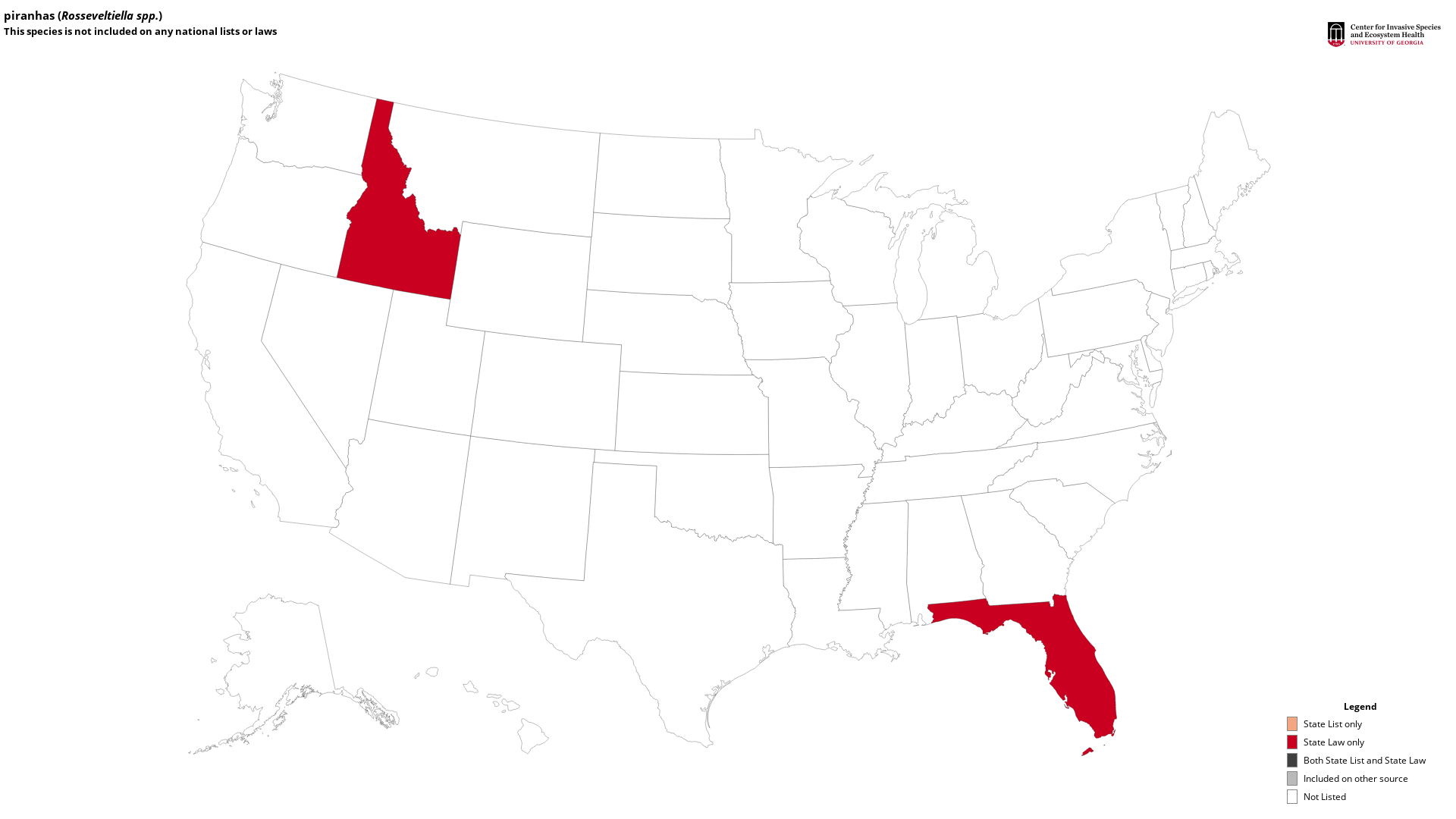piranhas
(Genus Rosseveltiella)
Origin
Piranhas are native to the central and southern river systems of South America, where they inhabit tropical rivers and streams and are often found in murky water.
Life Cycle
Piranhas are freshwater, tropical fishes belonging to the family Characidae, which also includes pacus and tetras. Piranhas have deep, laterally compressed bodies. They vary in color by location, population, and age, but many are silvery-gray or golden and some have bright colors such as red or orange on their head, belly, or fins. Piranhas have short, powerful jaws, and lower jaws that protrude beyond their upper jaws. Both jaws are lined with sharp triangular teeth, which allow piranhas to bite into and tear the flesh of their prey. Piranhas commonly grow to 12 inches in length and weigh less than two pounds, but have been reported to grow up to 16 inches and over 7 pounds.
Distribution
Piranhas are not currently found in California or elsewhere in the United States. Piranhas have been reported or collected in several states across the U.S. and in Lake Ontario, Canada, but no successful populations have established. In California, individual piranhas have been captured in Riverside County and Ventura County. Studies suggest piranhas may be able to overwinter and persist in the waters of southern California, if introduced, as water temperatures are comparable to their native range.
Control Efforts
Piranhas are not established in California. If you capture one please immediately kill it and report it to the California Department of Fish and Wildlife. California prohibits the importation, transportation, or possession all species of piranhas per C.C.R. Title 14, § 671.
Piranhas are native to the central and southern river systems of South America, where they inhabit tropical rivers and streams and are often found in murky water.
Life Cycle
Piranhas are freshwater, tropical fishes belonging to the family Characidae, which also includes pacus and tetras. Piranhas have deep, laterally compressed bodies. They vary in color by location, population, and age, but many are silvery-gray or golden and some have bright colors such as red or orange on their head, belly, or fins. Piranhas have short, powerful jaws, and lower jaws that protrude beyond their upper jaws. Both jaws are lined with sharp triangular teeth, which allow piranhas to bite into and tear the flesh of their prey. Piranhas commonly grow to 12 inches in length and weigh less than two pounds, but have been reported to grow up to 16 inches and over 7 pounds.
Distribution
Piranhas are not currently found in California or elsewhere in the United States. Piranhas have been reported or collected in several states across the U.S. and in Lake Ontario, Canada, but no successful populations have established. In California, individual piranhas have been captured in Riverside County and Ventura County. Studies suggest piranhas may be able to overwinter and persist in the waters of southern California, if introduced, as water temperatures are comparable to their native range.
Control Efforts
Piranhas are not established in California. If you capture one please immediately kill it and report it to the California Department of Fish and Wildlife. California prohibits the importation, transportation, or possession all species of piranhas per C.C.R. Title 14, § 671.
Maps
State Lists - This map identifies those states that have this species on their invasive species list or law.
Invasive Listing Sources
Taxonomic Rank
| Domain: Eukarya |
| Kingdom: Animalia |
| Phylum: Chordata |
| Subphylum: Vertebrata |
| Class: Actinopterygii |
| Subclass: Neopterygii |
| Infraclass: Teleostei |
| Order: Characiformes |
| Family: Characidae |
| Rosseveltiella |

